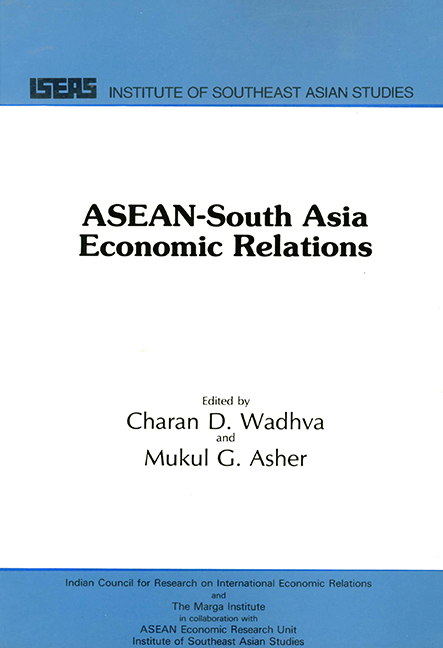Book contents
- Frontmatter
- Contents
- Foreword
- Exchange Rates of ASEAN and South Asian Countries
- An Overview
- PART ONE ASEAN COUNTRY STUDIES
- PART TWO SOUTH ASIA COUNTRY STUDIES
- Bangladesh-ASEAN Trade Relations
- Bangladesh-ASEAN Investment Relations
- India-ASEAN Economic Relations
- Nepal-ASEAN Economic Relations
- Sri Lanka-ASEAN Economic Relations
- Postscript
- Appendix SITC Classification at One-, Two-, and Three-digit Levels
- THE EDITORS
Nepal-ASEAN Economic Relations
from PART TWO - SOUTH ASIA COUNTRY STUDIES
Published online by Cambridge University Press: 21 October 2015
- Frontmatter
- Contents
- Foreword
- Exchange Rates of ASEAN and South Asian Countries
- An Overview
- PART ONE ASEAN COUNTRY STUDIES
- PART TWO SOUTH ASIA COUNTRY STUDIES
- Bangladesh-ASEAN Trade Relations
- Bangladesh-ASEAN Investment Relations
- India-ASEAN Economic Relations
- Nepal-ASEAN Economic Relations
- Sri Lanka-ASEAN Economic Relations
- Postscript
- Appendix SITC Classification at One-, Two-, and Three-digit Levels
- THE EDITORS
Summary
INTRODUCTION
Nepal's economic relations with the members of the Association of Southeast Asian Nations (ASEAN), mainly through trade and in a very small way through investment in joint ventures, are of relatively recent origin. From time immemorial, Nepal's economic relations have been primarily confined to its large neighbour, India. This was so until the early 1970s. Thus, as late as in 1974/75, Nepal's exports to the group of five ASEAN countries (namely, Indonesia, Malaysia, Philippines, Singapore and Thailand) constituted only 2 per cent of its total exports to the world, whereas its exports to India constituted 84 per cent of its total exports (see Table 2). Similarly, Nepal's imports from all the ASEAN countries in the same year made up nearly 2 per cent of its total imports from the world whereas the corresponding proportion of imports from India was 81 per cent. This position can easily be explained by the land-locked nature of the country and the traditional open border and easier transportation links existing with India for centuries, and also by the similarities in cultural, social, and religious values between the two countries. Until the 1960s, Nepal had exclusively depended on India for providing transit facilities for its trade with the countries overseas. Transportation links with its other large neighbouring country, China, have traditionally been weaker due to high mountains and difficult terrain.
It was only during the seventies that Nepal consciously started programmes of diversification of its economic relations with countries other than India, especially with the other countries of South Asia and the ASEAN grouping. This paper traces the changing profile of Nepal's economic relations with the ASEAN countries since 1974/75. The data base for Nepal's economy is quite weak. However, to the extent that data are available, we will draw upon them from the national and international sources. While the primary focus of the study will be on trade relations (Section II), “other economic relations” (such as investment in joint ventures in industries) will also be touched upon (Section III).
- Type
- Chapter
- Information
- ASEAN-South Asia Economic Relations , pp. 321 - 340Publisher: ISEAS–Yusof Ishak InstitutePrint publication year: 1985

